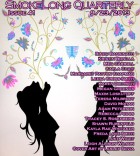Structurally, the story is comprised of two parts: the first, a portrait of the town as the narrator ages; the second, a scene (two half-scenes actually) from college. How did you decide on this structure? Did it come naturally to you?
AND
Some writers can struggle with the manipulation of time in stories. How do you move so fluidly in a few pages through time, taking the narrator from elementary school up to college?
That’s the wonderful thing about the element of place in a story, isn’t it? When it assumes focus, place can dictate all other elements to its terms. Time blurs, pacing and character fall in line with its stride. I think starting with the processing plant itself was the only way I knew to tell the story, particularly when I first started writing it—putting the lens on the factory and letting life, including the narrator’s youth, happen in its orbit. That the narrator reaches adulthood in a blink, and the story winds its way back to her, are offshoots of this approach. It’s a neat trick, one I didn’t recognize until I was a few drafts in and able to sit back, take a wider look at the thing I’d written, and realize, oh hey, wait, it actually works. Initially, it was a gut decision, and the sort of logic and awareness of structure that tends to rule revision tactics came later. It usually takes a few rounds for me to zoom out and recognize these larger elements at play because I’m so hellbent on getting the story right. It’s that potential for surprise—and the feverish hope that all the pieces will come together—that keeps me in my seat writing.
One of the things I love about this story is how you keep the attention of the story on these tack-sharp images and authentic details, like the Dairy Queen double-taping the windows or the chicken dust on the windshields of the cars. How do you strike a balance between the politics of the story (i.e., environmental hazards and agribusiness) and the more human story? How do you avoid making the story didactic? Is this something you were cautious of when writing it?
If the story takes precedence over other motivations, it will never be didactic. The most affecting details in any account of an environmental inequity are the human details, the smaller, sensory bits. If you’re from the Kentucky coal fields, you were accustomed to wading in the creek as a kid and coming out with orange feet from all the runoff. If you lived in a town bordering a North Carolina hog lagoon, you would have a very specific, very personal terminology for the smell and taste of the air surrounding your home. I’m most interested in how these details, as gruesome and difficult as they are, integrate themselves into the larger business of people’s lives. If a story is honest, it will hit the right balance.
There’s a beautiful, understated bond between the narrator and her father throughout the story that takes on a different valence by the end of the story. How did you arrive at this ending?
Every time I sat down to work on this piece and spend time with this character, I had a sense of oncoming grief I could not shake. It’s the very specific kind of grief one might expect from someone who has a chronically ill parent—death is imminent, you can see it approaching on the horizon, and you know you cannot stop what’s coming. The process of losing begins before the actual loss. The narrator anticipates the grief, and I imagined her sifting through her memories, trying to find clues and harbingers of these awful things to come as a way to control the elements and not feel so powerless. I always had the sense of the ultimate ending being that she’s going to nibble herself to death this way, because she will never fail to find these clues too late to be of use to anyone. She will dwell on that factory for years wondering what, exactly, it did to her father. Her love for him is already punctured through with loss, turning it into something that holds you instead of the other way around. In my mind, that’s the bond, beautiful and troubling in turns.
Can you talk about your process in writing this piece? Did you agonize over every line? Where did your inspiration come from? How many drafts did you go through?
5. This piece went through a lot of drafts. 15? 20? I’m a reviser. I just worry and worry over that stuff. It’s hard to quit. When I teach, I push editing constantly. It’s the only way to build the story, I believe. The only real way to get it done. And anything a thousand words or under has to be rubber-band tight. There was a lot of cutting and clipping and zeroing in and panning out until the story finally held just enough, and I was as happy as I was ever going to be with it.
I live in New York now, but I was born and raised in Eastern Kentucky, right about the place where tobacco ends and coal country begins. There’s a big part of me that feels like I’m going to live and die in my hometown forever. It is my biggest source of inspiration, and it’s less conscious decision than simply the place my brain puts me. I expect I’m as bad as the next writer for filching stories out of the people and places I know. This one comes courtesy of my brother, who went to a wedding in a far-off town that contained, among other things, a chicken processing plant. And, as you might imagine, a pretty pervasive chicken shit smell. I couldn’t stop thinking about it after he told me. What would it be like to grow up there and to know that that was the world? Probably not too different, I realized, from growing up where I did. Wherever I go, I think I’ll have the feeling of pressing my nose up against the glass, watching whatever I can’t touch, and mooning, “Ooh, so that’s the outside world.” Taking that untouchable other world and bringing it back home, making it my life, in a way—it’s probably the biggest impetus for writing that I have found.



 The core workshop of SmokeLong Fitness is all in writing, so you can take part from anywhere at anytime. We are excited about creating a supportive, consistent and structured environment for flash writers to work on their craft in a community. We are thrilled and proud to say that our workshop participants have won, placed, or been listed in every major flash competition. Community works.
The core workshop of SmokeLong Fitness is all in writing, so you can take part from anywhere at anytime. We are excited about creating a supportive, consistent and structured environment for flash writers to work on their craft in a community. We are thrilled and proud to say that our workshop participants have won, placed, or been listed in every major flash competition. Community works.